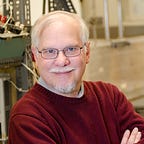Science Knows, Actually
“It’ll start getting cooler. You just watch,” — President Trump
“I wish science agreed with you,” — California official.
“I don’t think science knows, actually,”- President Trump.
It’s nice to know that President Trump understands Milankovitch cycles. In 1976 it was conclusively demonstrated that the multiple advances and retreats of the Northern Hemisphere ice sheets over the last 2.5 million years are controlled by small periodic changes in the Earth’s orbit[i], a hypothesis put forth decades earlier by Milutin Milanković. Over roughly the last one million years, the ice has grown and retreated on a cycle of about 100,000 years, with the growth of the ice being gradual and the decline relatively sudden, producing a distinctive “saw-tooth[ii]” The last deglaciation occurred between 20,000 and 10,000 years ago, with global warmth peaking about 6,000 years before present. So, indeed, the world should “start getting cooler” and in fact already has a bit. But this is a very slow cooling and will not be noticeable for millennia. That is, if natural processes are allowed to run their course. The problem is that we have altered these processes.
The key to this is what “science knows.” We know that ice ages come and go and that we are in the early part of an interglacial period. As documented in a great just published paper (see figure), we know that climate has gradually cooled for most of the last 50 million years, producing the onset of glaciation in Antarctica about 35 million years ago and culminating in extensive Northern Hemisphere ice sheets about 2.5 million years ago; the Icehouse world. We know that humanity evolved, and our society developed, during the Icehouse and the current relatively warm interglacial period. We know that for at least the last 800,000 years atmospheric carbon dioxide varied between 170 parts per million (ppm) during glacial times and about 280 ppm during interglacial periods and was almost certainly no more than 300 ppm for millions of years before that. And we know that global temperature over Earth history has closely followed levels of carbon dioxide in the atmosphere, with high CO2 levels associated with high temperatures. What we know provides the context for understanding the natural processes of climate change relevant to humanity.
What we know tells us that we are entering a time unlike any other in the history of human society or even our species. Currently, the level of CO2 in the atmosphere has reached 411.3 ppm. The last time carbon dioxide reached these levels is just before the start of the ice ages, some 3 million years ago. Current projections suggest that by 2100 the value will be between 500 ppm and 1000 ppm, depending on if emissions are controlled (the higher number is “business as usual”). Even if we assume the lower number, that corresponds to conditions about 20 million years ago; the higher figure has not been seen for some 50 million years. The corresponding temperature responses will drive us out of the current Icehouse back to the Coolhouse or even the Hothouse. And it is doing it very fast, far faster than Milankovitch cycle induced cooling.
As I write this, forest fires envelope the American west and Siberia. The west has seen record setting temperatures, including the highest temperature ever recorded, as well as continuing drought, setting the stage for the fires. This summer was the hottest ever recorded here in Chicago, nearly 50 above average; it was also very dry. Meanwhile, they have run out of names for hurricanes and are using Greek letters. There are ominous signs for the breakup of Antarctic ice shelves. All of this has been predicted for decades as the consequences of rising carbon dioxide levels and a rapidly warming world.
So, Mr. President, I wish science agreed with you. Unfortunately for us, it does not.
.
[i] Hays, J. D., J. Imbrie, and N. J. Shackleton. 1976. Variations in the Earth’s Orbit: Pacemaker of the Ice Ages. Science 194(4270):1121–1132.
[ii] Willeit, M., A. Ganopolski, R. Calov, and V. Brovkin. 2019. Mid-Pleistocene transition in glacial cycles explained by declining CO2 and regolith removal. Science Advances 5(4):eaav7337.
